酶的高通量筛选word版本
- 格式:ppt
- 大小:745.50 KB
- 文档页数:22
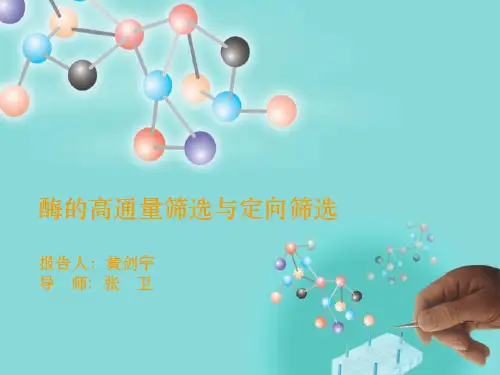
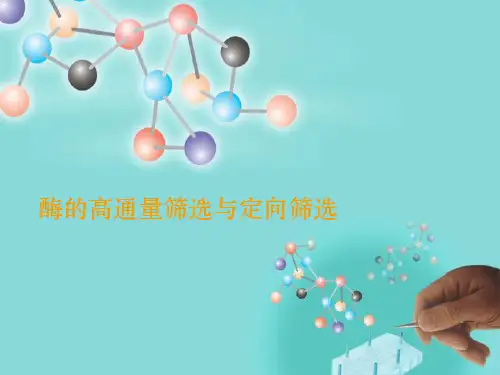
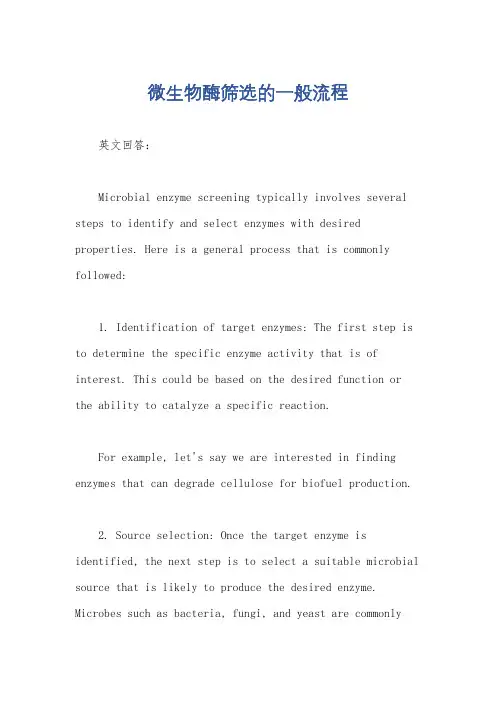
微生物酶筛选的一般流程英文回答:Microbial enzyme screening typically involves several steps to identify and select enzymes with desired properties. Here is a general process that is commonly followed:1. Identification of target enzymes: The first step is to determine the specific enzyme activity that is of interest. This could be based on the desired function or the ability to catalyze a specific reaction.For example, let's say we are interested in finding enzymes that can degrade cellulose for biofuel production.2. Source selection: Once the target enzyme is identified, the next step is to select a suitable microbial source that is likely to produce the desired enzyme. Microbes such as bacteria, fungi, and yeast are commonlyused sources.Continuing with our example, we could choose to screen cellulose-degrading enzymes from a variety of fungi known for their ability to break down plant material.3. Isolation and cultivation: The selected microbial source is isolated and cultivated under controlled conditions to optimize enzyme production. This may involve growing the microbe on specific media or in specialized bioreactors.In our case, we would isolate the chosen fungi and cultivate them in a nutrient-rich medium that promotes cellulase production.4. Enzyme extraction: Once sufficient enzyme production is achieved, the next step is to extract the enzymes from the microbial culture. This can be done through various methods such as centrifugation, filtration, or precipitation.For example, we could use centrifugation to separatethe fungal cells from the culture broth, and then collectthe supernatant containing the secreted enzymes.5. Enzyme screening: The extracted enzymes are then screened for the desired activity. This can be done through various assays and tests that measure the enzyme's abilityto catalyze the desired reaction.In our case, we could perform assays to measure the ability of the extracted enzymes to break down celluloseinto glucose.6. Enzyme characterization: Enzymes that show promising activity are further characterized to determine their properties. This may include studying their optimal pH and temperature range, stability, substrate specificity, and kinetic parameters.For example, we could determine the optimum temperature and pH at which the cellulase enzyme functions best, aswell as its ability to degrade different types of cellulose.7. Optimization and engineering: If needed, the selected enzyme can be further optimized or engineered to improve its properties. This can be done through techniques such as protein engineering or directed evolution.In our case, we could use protein engineering to modify the cellulase enzyme to make it more efficient in breaking down cellulose.8. Scale-up and production: Once the desired enzyme is identified and optimized, it can be scaled up for large-scale production. This may involve transferring the enzyme-producing strain to industrial fermentation systems and optimizing the production process.For example, we could transfer the selected fungal strain to a large-scale bioreactor and optimize the fermentation conditions for maximum cellulase production.Overall, the process of microbial enzyme screening involves identifying the target enzyme, selecting asuitable microbial source, isolating and cultivating the microbe, extracting and screening the enzymes,characterizing and optimizing the selected enzyme, andfinally scaling up production.中文回答:微生物酶筛选通常包括几个步骤,以确定和选择具有所需特性的酶。
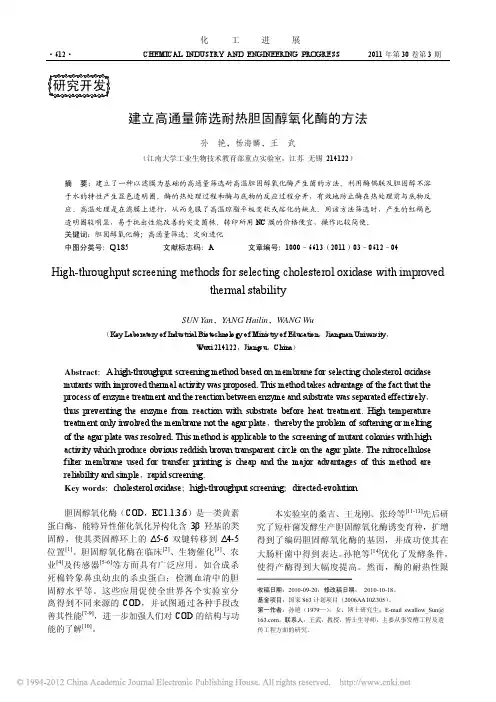
CHEMICAL INDUSTRY AND ENGINEERING PROGRESS 2011年第30卷第3期·612·化工进展建立高通量筛选耐热胆固醇氧化酶的方法孙艳,杨海麟,王武(江南大学工业生物技术教育部重点实验室,江苏无锡 214122)摘 要:建立了一种以滤膜为基础的高通量筛选耐高温胆固醇氧化酶产生菌的方法。
利用酶偶联及胆固醇不溶于水的特性产生显色透明圈。
酶的热处理过程和酶与底物的反应过程分开,有效地防止酶在热处理前与底物反应。
高温处理是在滤膜上进行,从而克服了高温琼脂平板变软或熔化的缺点。
用该方法筛选时,产生的红褐色透明圈较明显,易于挑出性能改善的突变菌株。
转印所用NC膜的价格便宜,操作比较简便。
关键词:胆固醇氧化酶;高通量筛选;定向进化中图分类号:Q 185 文献标志码:A 文章编号:1000–6613(2011)03–0612–04High-throughput screening methods for selecting cholesterol oxidase with improvedthermal stabilitySUN Yan,YANG Hailin,WANG Wu(Key Laboratory of Industrial Biotechnology of Ministry of Education,Jiangnan University,Wuxi 214122,Jiangsu,China)Abstract:A high-throughput screening method based on membrane for selecting cholesterol oxidase mutants with improved thermal activity was proposed. This method takes advantage of the fact that the process of enzyme treatment and the reaction between enzyme and substrate was separated effectively,thus preventing the enzyme from reaction with substrate before heat treatment. High temperature treatment only involved the membrane not the agar plate,thereby the problem of softening or melting of the agar plate was resolved. This method is applicable to the screening of mutant colonies with high activity which produce obvious reddish brown transparent circle on the agar plate. The nitrocellulose filter membrane used for transfer printing is cheap and the major advantages of this method are reliability and simple,rapid screening.Key words:cholesterol oxidase;high-throughput screening;directed-evolution胆固醇氧化酶(COD,EC1.1.3.6)是一类黄素蛋白酶,能特异性催化氧化异构化含3β羟基的类固醇,使其类固醇环上的Δ5-6双键转移到Δ4-5位置[1]。



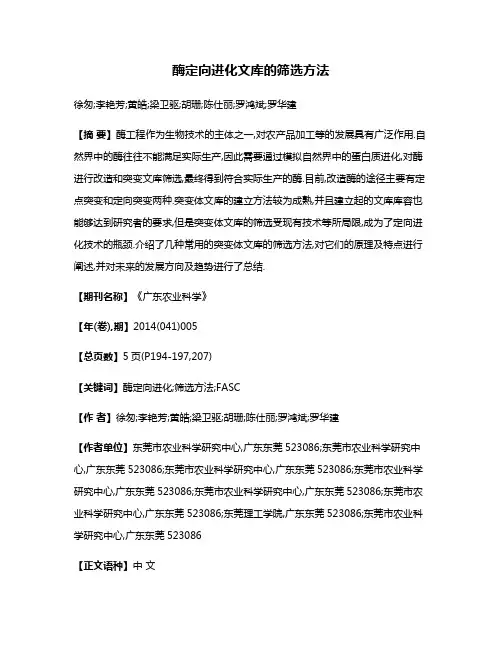
酶定向进化文库的筛选方法徐匆;李艳芳;黄皓;梁卫驱;胡珊;陈仕丽;罗鸿斌;罗华建【摘要】酶工程作为生物技术的主体之一,对农产品加工等的发展具有广泛作用.自然界中的酶往往不能满足实际生产,因此需要通过模拟自然界中的蛋白质进化,对酶进行改造和突变文库筛选,最终得到符合实际生产的酶.目前,改造酶的途径主要有定点突变和定向突变两种.突变体文库的建立方法较为成熟,并且建立起的文库库容也能够达到研究者的要求,但是突变体文库的筛选受现有技术等所局限,成为了定向进化技术的瓶颈.介绍了几种常用的突变体文库的筛选方法,对它们的原理及特点进行阐述,并对未来的发展方向及趋势进行了总结.【期刊名称】《广东农业科学》【年(卷),期】2014(041)005【总页数】5页(P194-197,207)【关键词】酶定向进化;筛选方法;FASC【作者】徐匆;李艳芳;黄皓;梁卫驱;胡珊;陈仕丽;罗鸿斌;罗华建【作者单位】东莞市农业科学研究中心,广东东莞523086;东莞市农业科学研究中心,广东东莞523086;东莞市农业科学研究中心,广东东莞523086;东莞市农业科学研究中心,广东东莞523086;东莞市农业科学研究中心,广东东莞523086;东莞市农业科学研究中心,广东东莞523086;东莞理工学院,广东东莞523086;东莞市农业科学研究中心,广东东莞523086【正文语种】中文【中图分类】Q814生物技术是当今发展最迅速、应用领域最广泛的高新技术。
农业生物技术正在成为农业竞争的焦点和核心,酶工程作为生物技术中重要的组成部分,是现代酶学理论与化学技术的交叉学科[1],酶制剂在农产品加工,如淀粉、甜味剂、乳品、果蔬贮藏、饲料加工等方面都有广泛应用。
随着生物技术和酶动力学的研究进步,酶学进入了一个快速发展的阶段。
1个多世纪以来,酶的特殊催化功能和效果使其在很多领域都代替了非生物催化剂。
目前全世界都在倡导可持续发展、可再生资源利用,使用清洁生产技术已经成为不可回避的应用技术现状,而使用酶制剂是其中非常重要的一部分。
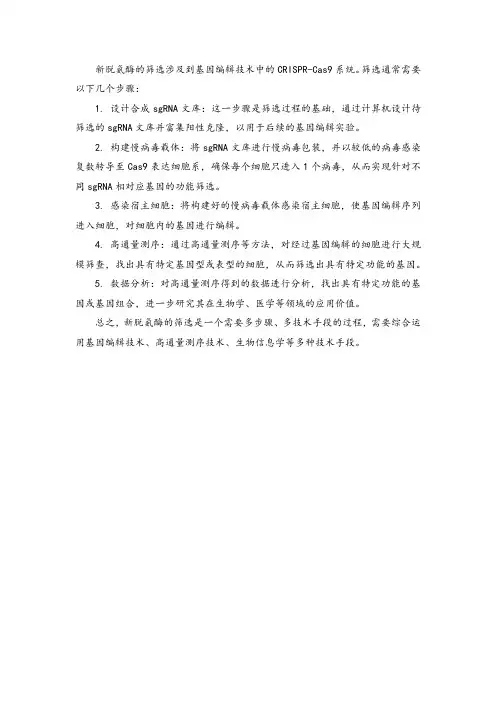
新脱氨酶的筛选涉及到基因编辑技术中的CRISPR-Cas9系统。
筛选通常需要以下几个步骤:
1. 设计合成sgRNA文库:这一步骤是筛选过程的基础,通过计算机设计待筛选的sgRNA文库并富集阳性克隆,以用于后续的基因编辑实验。
2. 构建慢病毒载体:将sgRNA文库进行慢病毒包装,并以较低的病毒感染复数转导至Cas9表达细胞系,确保每个细胞只进入1个病毒,从而实现针对不同sgRNA相对应基因的功能筛选。
3. 感染宿主细胞:将构建好的慢病毒载体感染宿主细胞,使基因编辑序列进入细胞,对细胞内的基因进行编辑。
4. 高通量测序:通过高通量测序等方法,对经过基因编辑的细胞进行大规模筛查,找出具有特定基因型或表型的细胞,从而筛选出具有特定功能的基因。
5. 数据分析:对高通量测序得到的数据进行分析,找出具有特定功能的基因或基因组合,进一步研究其在生物学、医学等领域的应用价值。
总之,新脱氨酶的筛选是一个需要多步骤、多技术手段的过程,需要综合运用基因编辑技术、高通量测序技术、生物信息学等多种技术手段。
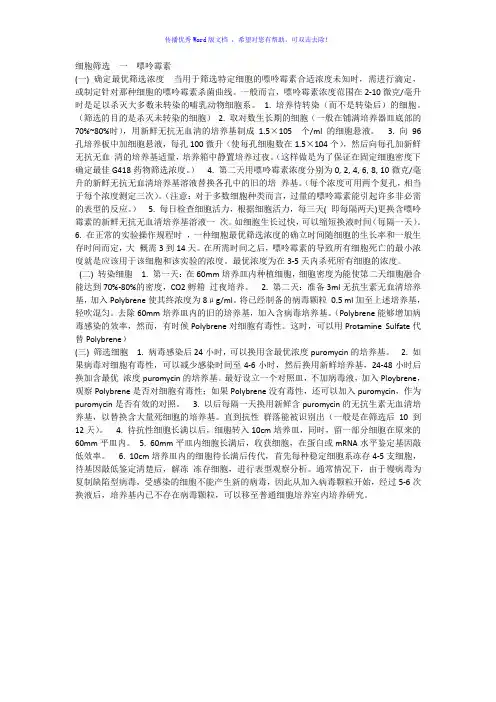
细胞筛选一嘌呤霉素(一) 确定最优筛选浓度当用于筛选特定细胞的嘌呤霉素合适浓度未知时,需进行滴定,或制定针对那种细胞的嘌呤霉素杀菌曲线。
一般而言,嘌呤霉素浓度范围在2-10微克/毫升时是足以杀灭大多数未转染的哺乳动物细胞系。
1. 培养待转染(而不是转染后)的细胞。
(筛选的目的是杀灭未转染的细胞)2. 取对数生长期的细胞(一般在铺满培养器皿底部的70%~80%时),用新鲜无抗无血清的培养基制成1.5×105 个/ml 的细胞悬液。
3. 向96孔培养板中加细胞悬液,每孔100微升(使每孔细胞数在1.5×104个),然后向每孔加新鲜无抗无血清的培养基适量,培养箱中静置培养过夜。
(这样做是为了保证在固定细胞密度下确定最佳G418药物筛选浓度。
) 4. 第二天用嘌呤霉素浓度分别为0, 2, 4, 6, 8, 10微克/毫升的新鲜无抗无血清培养基溶液替换各孔中的旧的培养基。
(每个浓度可用两个复孔,相当于每个浓度测定三次)。
(注意:对于多数细胞种类而言,过量的嘌呤霉素能引起许多非必需的表型的反应。
) 5. 每日检查细胞活力,根据细胞活力,每三天( 即每隔两天)更换含嘌呤霉素的新鲜无抗无血清培养基溶液一次。
如细胞生长过快,可以缩短换液时间(每隔一天)。
6. 在正常的实验操作规程时,一种细胞最优筛选浓度的确立时间随细胞的生长率和一般生存时间而定,大概需3到14天。
在所需时间之后,嘌呤霉素的导致所有细胞死亡的最小浓度就是应该用于该细胞和该实验的浓度。
最优浓度为在3-5天内杀死所有细胞的浓度。
(二) 转染细胞 1. 第一天:在60mm培养皿内种植细胞,细胞密度为能使第二天细胞融合能达到70%-80%的密度,CO2孵箱过夜培养。
2. 第二天:准备3ml无抗生素无血清培养基,加入Polybrene使其终浓度为8μg/ml。
将已经制备的病毒颗粒0.5 ml加至上述培养基,轻吹混匀。
去除60mm培养皿内的旧的培养基,加入含病毒培养基。